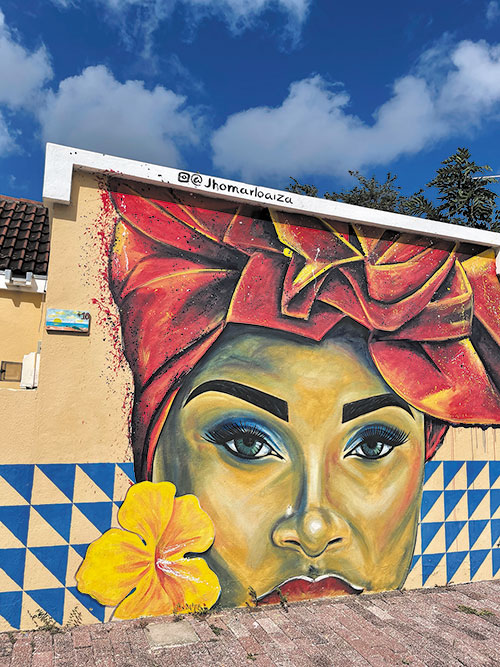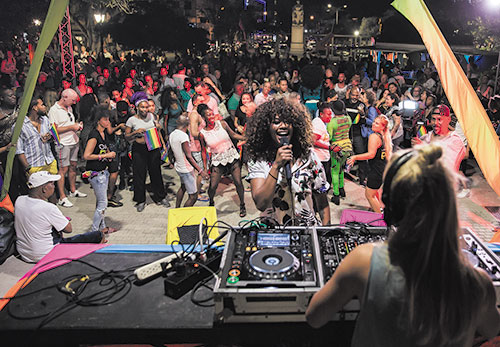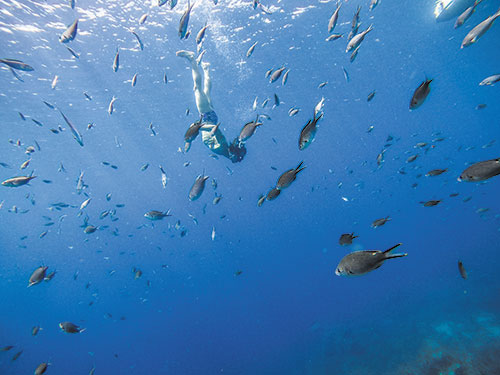Photo by Ed Salvato
Your LGBTQ-friendly Caribbean fantasy beckons
ED SALVATO | Contributing Writer
ed@edsalvato.com
Curaçao is best known for the richly-colored colonial architecture in its capital city, Willemstad, a UNESCO World Heritage Site. Its appeal lies in its unique blend of cultures, warm and LGBTQ-friendly locals, pristine blue-green waters and white sand cove beaches, as well as its diverse cuisines and complex history.

Photo by Ed Salvato
The population of 160,000 is spread across 171 square miles of this kidney-shaped island located 40 miles from Venezuela and comprising at least 55 nationalities. Most locals speak four languages: Papiamento (a Spanish and Portuguese-based creole language), Dutch, Spanish and English — a fluidity that empowers nimble thinking and open-mindedness.
You won’t find the dispiriting poverty here that you would find elsewhere in the Caribbean, since Curaçao has a higher per capita income, a basic income in time of need and universal health care.
Same-sex marriages aren’t performed locally, though they are legally recognized. Curacao Pride (CuracaoPride.com) takes place in the fall, which is also a great time to visit, since families with kids have gone back to school and much of the rest of the Caribbean is fretting about hurricanes.
Awe-inspiring art is found everywhere: live music, colorful murals, plein-air (and even underwater) sculptures and art galleries crammed into historic alleyways in Willemstad. Find more trip-planning information at Curacao.com/en/.
STAY
Curaçao offers a wide variety of accommodations options from modest AirBnBs to ultraluxury hotels and most major U.S. brands, but to maximize your local experience (without sacrificing quality), we recommend dividing a four- or five-night stay between the Bario, for its proximity to historic sites and wide variety of cuisines, and the Dream/Zoetry complex, to wind down your experience in a luxurious beach-side setting.
Local entrepreneurs — one of whom is openly gay — opened the Bario Hotel (Bariohotel.com), a chic property in an increasingly gentrifying neighborhood that is just a short walk to Willemstad. It offers unique units — some with kitchenettes— in restored and colorfully-painted historic buildings. The restaurant/lounge area boasts three local eateries. There is a pool on most nights there’s a DJ or live music, but not to worry early risers; it quiets down by midnight.

Photo by Ed Salvato
The all-inclusive Dreams Resort Hotel, Spa & Casino (AMRCollection.com/en/resorts-hotels/dreams/curacao/curacao-resort-spa-casino) and Zoëtry Curaçao (AMRCollection.com/en/resorts-hotels/zoetry/curacao/curacao-resort-spa) share a dreamy location in the leafy fishing community of Piscadera, a 10-minute drive from Willemstad on Curaçao ’s southwest-facing coast.
Think turquoise waters, glorious sunsets and not a care in the world. Make sure you have at least one meal of fresh seafood at Oceana at the edge of the bay. You’ll often find groups of queer locals hanging at Crafty Iguana Brew Pub.
Zoëtry is pricier but there are far fewer families, and, while both are LGBTQ-friendly, this one is exuberantly so.
EAT/DRINK
The Willemstad area boasts myriad culinary influences and mouthwatering fresh seafood and other specialties, whether at the most expensive haute-cuisine Dutch dining room or a humble beach shack. Mosa/Caña Bar & Kitchen (Mosacana.com) combines two previously separate concepts: Mosa serves international, tapas-stye dishes and shared plates in a homey environment, while Caña is a Latin-inspired Caribbean bar and kitchen offering tacos, ceviche and other fresh seafood and meat dishes.

Photo by Ed Salvato
Bario Urban Street Food (BarioStreetFood.com) at the eponymous hotel offers a range of food styles in an outdoor market environment: upscaled street food, plant-based delights and a variety of dishes involving the invasive but delicious lionfish.
While sightseeing downtown, carve out an hour for lunch at Marshe Bieu (TripAdvisor.com/Restaurant_Review-g147278-d10687500-
Reviews-Old_Market_Plasa_Bieu-Willemstad_Curacao.html), an authentic local food hall located in the heart of Punda. It offers a wide variety of local dishes with ingredients fished, farmed or cooked up that day. Try bonchi kòra (red bean soup) and funchi (fried polenta).
In the vibrant ex-pat popular Pietermaai area BijBlauw, (Bijblauw.com/restaurant?lang=en) offers sophisticated Dutch takes on local cuisine. It’s pricey, and you’ll mostly find other North American and European patrons, but the outdoor beachside setting is gorgeous.
At the other end of the price and sophistication scale, one of the most highly recommended food experiences is Kas di Piskado Purunchi (Facebook.com/Piskafresku), an example of what locals call a fish shack — a casual indoor/outdoor restaurant perched on an inlet just outside of Willemstad on route to the airport. There’s usually just one daily option comprised of fresh fried fish, served with fresh salad, fried banana and avocado and krioyo sauce.

Pride 2017 with Shary an Nivillac (Photo by Diamond PR)
SEE/DO
First things first, soak up the rich, complicated history (involving the slave trade) of Curaçao and its friendly vibe, sparkling water views, eyepopping colors and abundant art with Step-by-Step Curaçao (StepByStepCuracao.com/2021/08/02/island-tour), which offers a two-hour city tour on electric-powered, step-on seatless bikes with fat tires that can easily power up the occasional steep hills, all for $30 per person. This tour covers the major sites, including the 1888 floating Queen Emma Bridge, the sand-floored, 17th-century Mikvé Israel-Emanuel Synagogue, the architecture and plazas of Willemstad, local neighborhoods and numerous stops to ogle artwork and sample local snacks.
The best place to taste authentic Blue Curaçao liqueur is the Curaçao Liqueur Distillery at Landhuis Chobolobo (CuracaoLiqueur.com/brand/the-curacao-liqueur-distillery), offering a fun, fast-paced tour tracking the history of the island through this potent azure liqueur in a distinctive bumpy glass bottle. The tours include samples and the opportunity to enjoy or even mix Blue Curaçao-based cocktails.

Curaçao Fish Pier (Photo by Diamond PR)
Klein Curaçao
Curaçao’s flag includes two stars. One is for Klein (or little) Curaçao, an uninhabited island eight miles off the southeast coast with an abandoned lighthouse, several shipwrecks and the longest and whitest sand beach in the country. It’s a two-hour catamaran tour with the expert seafarers of Blue Finn (BlueFinnCharters.com) that features an appetizing all-you-can eat lunch, cocktails, music and some narration.
GO WEST
Rent a car from your hotel to visit Westpunt, the rural, western part of the island, home to Curaçao’s most beautiful beaches, a sprawling national park and plantation houses — beautiful but stark reminders of slavery. First, head to Shete Boka National Park (SheteBokaPark.org), adjacent to Christoffel Park, home of the highest peak on the island. The park covers more than six miles of the north coast of the island. It is exposed to rocky waves and features 10 small bays where three species of sea turtles are known to lay eggs, and it includes the famous Boka Tabla cave.
 A highlight of your visit will be the SEABOB Experience with Bearded Butlers Curaçao at Playa Piskadó with Andy, the incredibly handsome owner. Think of it as a handheld underwater electric jet ski enabling you to dive and swim quickly underwater for as long as you can hold your breath. No training or certification is required. It’s $90 for an hour, and Andy points out significant underwater elements including sea turtles and art placed on the sea floor!
A highlight of your visit will be the SEABOB Experience with Bearded Butlers Curaçao at Playa Piskadó with Andy, the incredibly handsome owner. Think of it as a handheld underwater electric jet ski enabling you to dive and swim quickly underwater for as long as you can hold your breath. No training or certification is required. It’s $90 for an hour, and Andy points out significant underwater elements including sea turtles and art placed on the sea floor!
Grab lunch at Karakter (KarakterCuracao.com), a beachside restaurant with delicious tapas, sandwiches and fresh-caught seafood. Conclude your exploration of the west with a relaxing afternoon on the beach at Playa Kenepa Grandi located on the far west side where you’ll find the vibrant, crystal-clear blue-green water and the pristine white sand beaches of your Caribbean fantasies.
N.Y.C.-based Ed Salvato is a freelance travel writer, instructor at NYU and the University of Texas at Austin’s NYC Center and an LGBTQ marketing specialist.
















